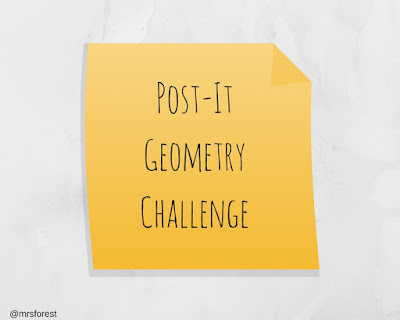Post-It Geometry Challenge
This activity is a fun investigation into symmetry. However, you don't have to wait until you are explicitly teaching geometry or symmetry. It encourages students to be precise and persevere in problem solving. Use it to help address those Standards for Mathematical Practice!
I think 4th grade and up would enjoy a few of these challenges. I've tried it with middle schoolers (6-8) as well as adults. I love the fact that this is an opportunity for all learners to engage in math at the same time. It might even be an opportunity for students that don't find as much success in math class to excel.
Here's how it works:
1. Put the picture of the post it notes with holes in it.
2. Students are challenged to take a post-it note and try to fold it so that with 1 single punch with a hole punch it will create this when opened back up.
I suggest showing this image first:
This one requires a simple fold of the post-it in half.
Walk through how this one works and let everyone have that successful experience so they are ready to take on the more challenging tasks to follow.
Here are a few more examples of challenges you could try:
(many students will fold in half "hamburger" and "hotdog" style for this one first before realizing you need diagonal folds"
(I've noticed this one is difficult for kids because they have little experience folding in thirds)
(If kids are stuck on this one, help them make the connection between this and other they have tried)
Here's the answer key:
A few things I've discovered by doing this activity several times:
- It is important to give students enough post-it notes so they are encouraged to keep trying. They should not be worried about making a mistake! There needs to be some trial and error as they move through the challenges.
- If you don't have a large supply of post-it notes, you could give students a small stack of paper cut into squares.
- I found it easier to be in charge of the hole punch. I walk around and punch when the student (or adult) is ready to test their ideas.
- Let students have the opportunity to fail. Punch the hole where they ask even if you know it won't work for them. Let them open it up and see where it went wrong.
- If a student is getting very frustrated after a few fails, it could help to give a focusing question such as, "How many layers should you be punching through to get that number of holes?" Or, "How can you use one of the previous challenges to help you figure out this one? What is the same or different this time?" But don't do it for them!!
- Think about the order to roll the challenges out to the class. The above sequence goes from easier to more difficult, so it might be a nice order to follow.
- Have a few extra challenges ready to give to students that are quickly solving these.
- If a student makes one that is an "interesting mistake," in other words, doesn't match the picture on the screen but makes one that would make for an interesting challenge in the future, save it! I even like to let that student know they didn't solve this puzzle, but their "interesting mistake" will make for a great one in the future and could I please keep it. It's a great way to validate the idea that sometimes mistakes turn into something great!












Comments
Post a Comment